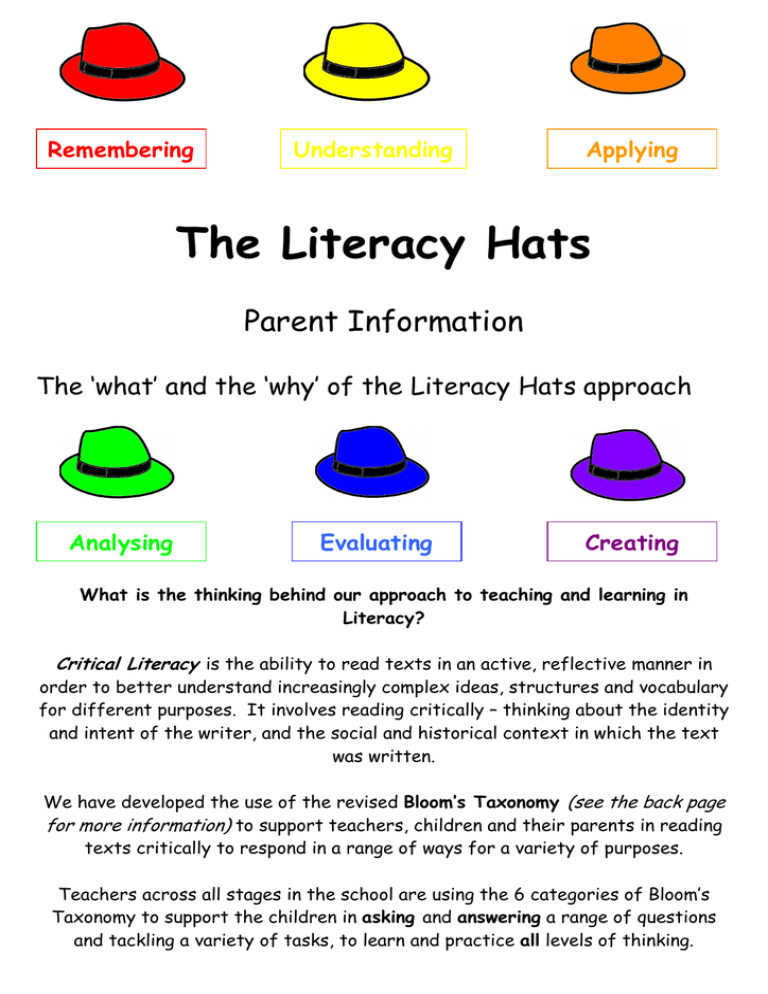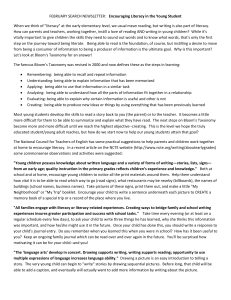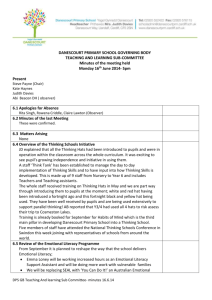The Literacy Hats
advertisement

Remembering Understanding Applying The Literacy Hats Parent Information The ‘what’ and the ‘why’ of the Literacy Hats approach Analysing Evaluating Creating What is the thinking behind our approach to teaching and learning in Literacy? Critical Literacy is the ability to read texts in an active, reflective manner in order to better understand increasingly complex ideas, structures and vocabulary for different purposes. It involves reading critically – thinking about the identity and intent of the writer, and the social and historical context in which the text was written. We have developed the use of the revised Bloom’s Taxonomy (see the back page for more information) to support teachers, children and their parents in reading texts critically to respond in a range of ways for a variety of purposes. Teachers across all stages in the school are using the 6 categories of Bloom’s Taxonomy to support the children in asking and answering a range of questions and tackling a variety of tasks, to learn and practice all levels of thinking. How can parents help their children to enhance their thinking skills at home? In some classes, the teacher is making full use of the Literacy Hats in classroom work so is focusing Homework tasks on other areas of the curriculum. However, homework tasks may involve children asking or answering questions related to one or more of the Literacy Hats. Below are some examples of question stems that may help you to help your children think of their own questions related to the different coloured hats (the different levels of thinking). There are also examples of the types of activities they may be asked to carry out to help them to use the different levels of thinking. Literacy Hat Question Stems Remembering • • • • How many...? Who was it that...? Describe what happened after… Which is true or false...? • • • • Can you explain why…? Can you write in your own words? How would you explain…? What do you think could have happened next...? • Do you know of another instance where…? Can you group by characteristics such as…? Which factors would you change if…? What questions would you ask of…? Understanding Applying • • • • • Analysing • • Evaluating Creating • • • • • • • • • • • Which events could not have happened? If. ..happened, what might the ending have been? How is...similar to...? What do you see as other possible outcomes? Is there a better solution to...? What do you think about...? Do you think...is a good or bad thing? How would you feel if. ..? What are the pros and cons of....? What are the alternatives? Can you see a possible solution to...? If you had access to all resources, how would you deal with...? What would happen if ...? Can you create new and unusual uses for...? Can you develop a proposal which would...? Possible Activities • • • • • • • • • • • • • • • • • • • • • • • • • • • • Make a list of the main events. Make a timeline of events. List all the …in the story. Make a chart showing.. Make a mindmap of what you know Illustrate what you think the main idea was. Make a cartoon strip showing the sequence of events. Retell the story in your own words. Write a summary report of an event. Construct a model to demonstrate how it looks or works Practise a play and perform it for the class Make a diorama to illustrate an event Write a diary entry Make a puzzle game using ideas from event Construct a model to demonstrate how it will work Use a Venn Diagram to show how two topics are the same and different Survey classmates to find out what they think about a particular topic. Analyse the results. Make a flow chart to show the critical stages. Classify the actions of the characters Write a letter to the editor Prepare and conduct a debate Prepare a list of criteria to judge… Write a persuasive speech arguing for/against… Evaluate the character’s actions in the story Invent a machine to do a specific task. Create a new product. Give it a name and plan a marketing campaign. Write about your feelings in relation to... Write a TV show play, puppet show, role play, song or pantomime about… In our Primary 1 and Primary 2 classes the children may not have been introduced to the Literacy Hats but their skills in asking and answering a range of questions, as well as undertaking tasks to promote the different kinds of thinking will be underway in preparation for the use of the Literacy Hats as they move through the school. Some classes are using a version of the grid below to introduce the children to Literacy Hats tasks: Task A Give the story marks out of ten. Write some sentences to explain your marks. Task D Draw a picture of your favourite person in this book. Write down his or her name. Task B Draw a picture of your favourite bit in the story. Colour it in. Task J What do you think might happen next in the story? Write 3 sentences to explain and draw a picture. Task E Make up three questions you could ask someone about this book to test if they have read it carefully. Task H Before reading the book, look at the front cover and think of 3 questions you would like to ask. Write these questions in your jotter. Task K Find 6 words from the story that start with the same first letter as your name. Task M Where was this story set? Draw a picture of the setting and write where it is. Task N Choose 5 words from the story and write your own rhyming word for each word. Task G Find 5 words in the book that begin with the same sound. Task C Write down three new words you have learned from the story. Task F Make up a sentence from this book. Why did you like this sentence? Task I How many characters were in your story? Write down their names in your jotter. Draw a picture of your favourite character. Task L Find another book that might have the same setting. (You may have this book at home or visit the local library) Read this book at home. Task O Copy your favourite sentence from the story. Why did you choose this one? A ‘Literacy Hats’ Parent Workshop is being held early in Term 4 to provide further information about this approach – Finalised date and information to follow… What is Bloom’s Taxonomy? In 1956, Benjamin Bloom headed a group of educational psychologists who developed a classification of levels of intellectual behaviour important in learning. During the 1990's a new group of cognitive psychologists, lead by Lorin Anderson (a former student of Bloom), updated the taxonomy to reflect relevance to 21st century work. The taxonomy has been adapted for classroom use as a planning tool. It provides a way to organise thinking skills into six levels, from the most basic to the higher order levels of thinking. The Revised Blooms Taxonomy is used to inform our teaching approaches and support children’s development of higher-order thinking skills: Creating Generating new ideas, products, or ways of viewing things Designing, constructing, planning, producing, inventing. Evaluating Justifying a decision or course of action Checking, hypothesising, critiquing, experimenting, judging Analysing Breaking information into parts to explore understandings and relationships Comparing, organising, deconstructing, interrogating, finding Applying Using information in another familiar situation Implementing, carrying out, using, executing Understanding Explaining ideas or concepts Interpreting, summarising, paraphrasing, classifying, explaining Remembering Recalling information Recognising, listing, describing, retrieving, naming, finding How are the different categories of questions used in the classrooms? Typically a teacher would vary the level of questions within a single lesson. Lower level questions are those at the remembering, understanding and lower level application levels of the taxonomy. Usually questions at the lower levels are appropriate for: • Evaluating children’s comprehension • Identifying children’s strengths and weaknesses • Reviewing and/or summarising content Higher level questions are those requiring complex application, analysis, evaluation or creation skills. Questions at higher levels of the taxonomy are usually most appropriate for: • Encouraging children to think more deeply and critically • Problem solving • Encouraging discussions • Stimulating children to seek information on their own

